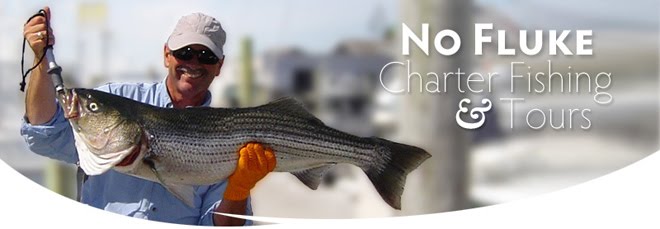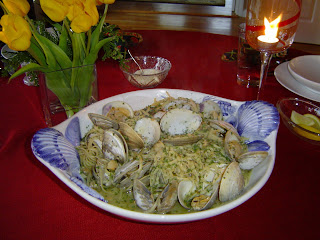9. Casting plastic shad swim baits. Many anglers love this technique and use it most often with success in the spring.
8. Buck tail jigs with pork rind squid strips. Have had success with this method to get under schools of blue fish to get at the striped bass on the bottom.
7. Live eels. Used by shore or boat anglers, some fishing guides use this as their primary method to catch killer stripers. Hook the eel through the mouth and out an eye. Going between the eyes usually kills the bait.
6. Live menhaden. Snag the live bait with a weighted treble hook. Hook the bait through the bridge of the nose, find the pod of fish again and put the live menhaden back into the pod of bait and let it swim. Used when menhaden are running strong, particularly up the Providence River in early spring.
5. Chucking fresh or frozen menhaden. Can anchor or fish moving bait pods with chunks. Can chum with chucks and pieces too. Some anglers use a weight slider to get the bait down to the striped bass.
4. Surface plugs. Have caught hundreds of school bass in the spring using surface plugs of all types.
3. Swimming lures. Great way to catch fish in coves, on rivers, etc. My friend Jim swears by Yo-Zuri Crystal Minnows.
2. Parachute squid jigs. Often used in ocean water (where there are squid). Anglers successfully use this method off Newport and Block Island.
1. Trolling with tube and worm. I have had great success using lead line on the Bay with red tubes. Hugely successful on the Southwest ledge off Block Island with 300 ft. of wire line out in 40 to 50 feet of water and using amber tubes.
There are other ways to catch striped bass. So e-mail me your favorite method(s) and we will share it with others.
New Proposed Fishing Regulations
The Rhode Island Department of Environmental Management (DEM) has proposed amendments to Marine Fisheries Regulations (both recreational and commercial) for several salt water species at a public hearing on Wednesday, April 22 at the URI Bay Campus. For a complete list of proposed regulation changes visit DEM’s Fish & Wildlife Web site at www.dem.ri.gov./progrmas/bnatres/fishwild/ .
At the meeting, DEM related a change in recreational summer flounder regulations necessary to properly manage the fishery. With input from fishermen and the industry, DEM’s Fish and Wildlife Division developed six different summer flounder recreational fishing regulation change options. Option four was the most popular option at the meeting. The proposed regulation increased the size to 21” (from 20”), reduced the per person per day bag limit from seven to six, and reduced the recreational fishing season for summer flounder from year round to June 13 through December 31.
Acting Marine & Wildlife director Mark Gibson related that DEM director, W. Michael Sullivan, will review the proposed change options, public comments and will develop recommendations. The Rhode Island Marine Fisheries Council will then vote on recommended changes.
My guess is that the approved changes will not be in effect before the summer flounder start to bite. But keep your eyes and ears open because regulations will likely change as the season progresses.
Where’s the bite
Striped bass. A lot of bait fish around the mouth of the Barrington River and at Rumstick Point, however no stripers. Ken Ferrara from Ray’s Bait & Tackle related customers caught fish using frozen herring chucks at Mill Cove near Conimicut Point. Angler Mike Shepard from Newport reports no striped bass around this weekend. Craig Mancini from Continental Bait & Tackle in Cranston said school stripers are being reported in and around the mouth of Narrow River. Dave Henault of Ocean State Tackle (Coventry/Providence/Bristol) reported Bob Oberg continues to catch stripers (31 this week) trolling in this kayak with tube and worm on the Thames River in CT. I fished Green River, Greenwich Bay and Greenwich Cove with no luck this past weekend. The water is warming up, bait is more visible so conditions are right for striped bass to start appearing soon.
Fluke. No fluke bite reported. See proposed DEM regulation changes above.
Fresh water bite still good. Anglers still catching fish at a variety of ponds, again not their limit but some nice fish. A lot of largemouth bass were taken this weekend at Meshanicut Lake reports Craig Mancini of Continental Bait & Tackle.
Captain Dave Monti has been fishing and shell fishing on Narragansett Bay for over 40 years. He holds a captain’s master license. Your fishing photos with captions, stories, comments and questions are welcome… there’s more than one way to catch a fish so e-mail Captain Dave at dmontifish@verizon.net .
Photo Caption A
Eric Appolonia of North Kingstown and I caught monster striped bass this fall using wire line and amber colored tube and worm on Block Island’s Southwest ledge. The largest fish that day was 46” and 40 lbs.
Photo Caption B
Angler Jim Malachowski of Cranston displays a 36” striped bass caught last spring using live menhaden on the Providence River.

.jpg)
.jpg)
.jpg)
.jpg)
.jpg)







+photo+A.jpg)
